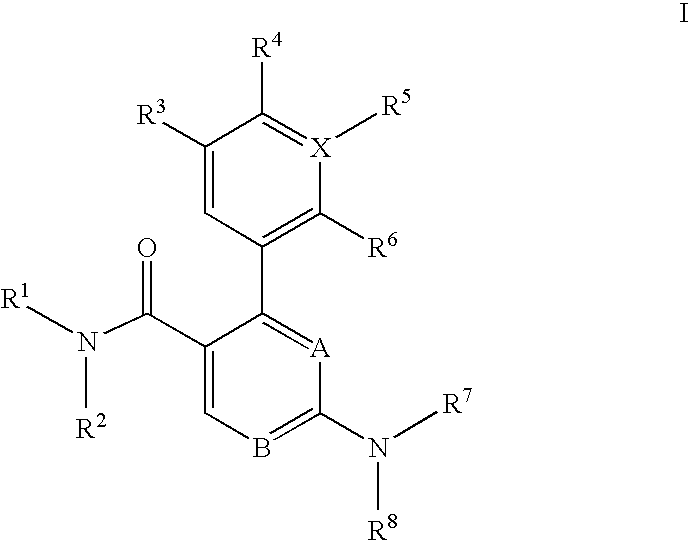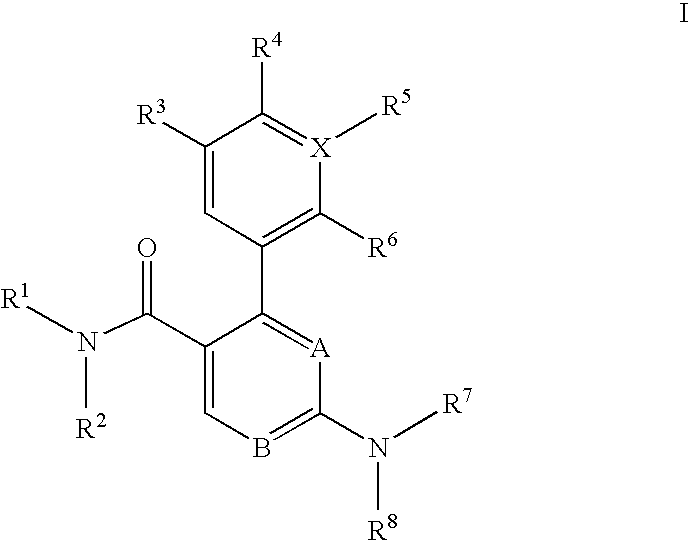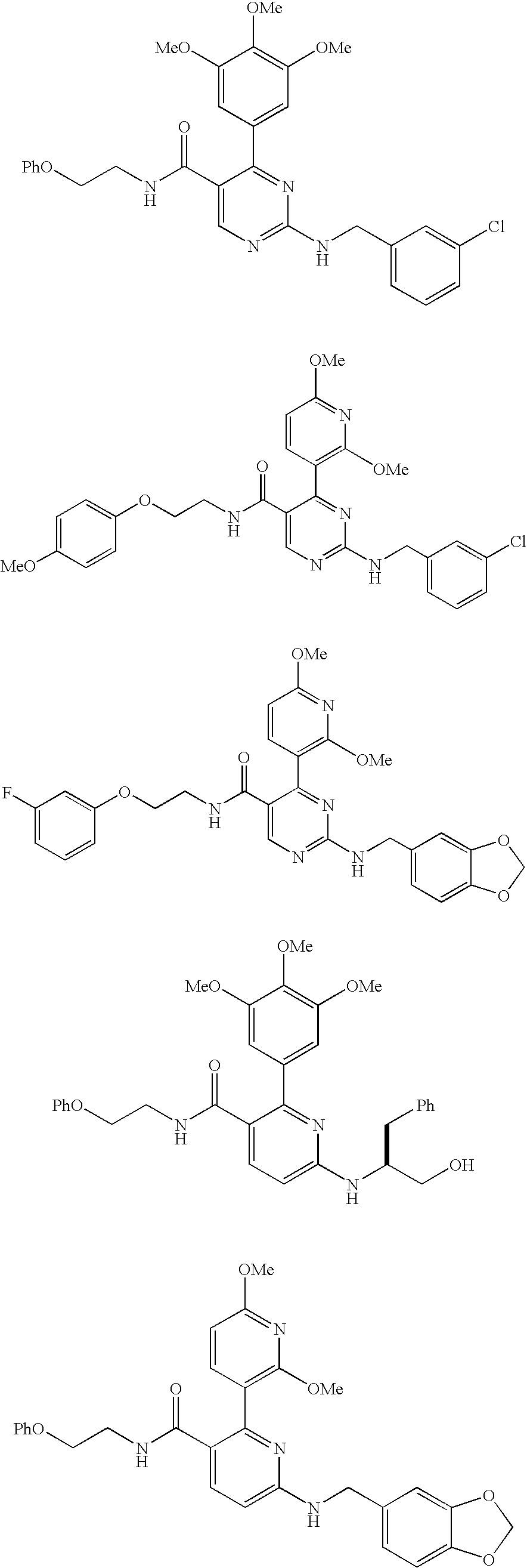Trisubstituted heteroaromatic compounds as calcium sensing receptor modulators
a calcium sensing receptor and heteroaromatic compound technology, applied in the field of new drugs, can solve the problems of increased bone turnover and subsequent loss of bone mass
- Summary
- Abstract
- Description
- Claims
- Application Information
AI Technical Summary
Benefits of technology
Problems solved by technology
Method used
Image
Examples
example 1
To a mixture of pyrazole-1-carboxyimidine (1.46 g, 10 mmol), benzylmethylamine (1.21 g, 10 mmol), and N,N-diisopropylethylamine (1.74 mL, 10 mmol) was added DMF (5 mL). The reaction mixture was stirred at room temperature overnight. Ether (50 mL) was added, and the product which became an oil was at the bottom of the flask. The mixture was sonicated and the top ether layer was decanted. This process was repeated several times until the product solidified. The solid was dried under high vacuum overnight to provide the title compound (2.0 g, 100%) as a white solid.
MS (ES+) m / z (M+H)+=164.33.
1H NMR (400 MHz, CD3OD): δ 2.91 (s, 3H), 4.51 (s, 2H), 7.24 (m, 5H).
HPLC: Retention time=0.79 min (Method B).
To a 100 mL Erlenmyer flask was added anhydrous EtOH (40 mL) and sodium metal (460 mg, 20 mmol) piece by piece. The mixture was stirred at room temperature for 20 minutes until no sodium was visible. The NaOEt solution was added to a flask containing the Part A compound (1.99 g, 10 ...
example 2
To a water-cooled solution of dimethylmalonate (132 g, 1 mol) in MeOH (500 mL) was added KOH (56 g, 1 mol) portionwise. The reaction mixture was stirred for 16 h, the solid was filtered off, and the filtrate was condensed to ˜100 mL. Ether was added to precipitate out the solid, which was filtered and washed with ether, then dried to yield a white solid (102 g, 65%).
To a mixture of 3,4,5-trimethoxybenzoic acid (24.7 g, 116 mmol) and carbonyldiimidazole (20.8 g, 128 mmol) was added dry THF (300 mL) (Caution: gas evolution). The reaction mixture was stirred at room temperature for 4 h, then the Part A compound (20 g, 128 mmol) and MgCl2 (12.2 g, 128 mmol) were added portionwise. The reaction mixture was stirred at 40° C. for 2 days. The resulting precipitate was removed by filtration, and the filtrate was diluted with water and acidified with 1N HCl until pH ˜4. The mixture was extracted with ether (200 mL) and washed with water (2×100 mL), aq. NaHCO3 and water, then dried over Mg...
example 3
A solution of the Example 2 Part D compound (0.350 g, 1.0 mmol) and N-chlorosuccinimide (0.134 g, 1.0 mmol) in chloroform (2 mL) was stirred at 80° C. for 3 h. The reaction was cooled to room temperature and the excess solvent was removed in vacuo. Column chromatography on silica gel (0% to 50% ethyl acetate in hexane) gave 0.293 g of the aryl chloride as a white solid.
1H NMR (400 MHz, CDCl3): δ 9.05 (s, 1H), 6.76 (s, 1H), 3.95 (s, 3H), 3.92 (s, 3H), 3.89 (s, 3H), 3.76 (s, 3H), 2.63 (s, 3H).
HRMS m / z Calc'd. for C16H18N2O5SCl [M+H]+: 385.0625. Found 385.0635.
HPLC: Retention time=3.25 min (Method F).
To a clear, colorless solution of the Part A compound (0.280 g, 0.73 mmol) in THF (2.4 mL) was added KOTMS (0.135 g, 0.95 mmol). The resulting yellow solution was stirred at room temperature for 24 h. The reaction was diluted with water (10 mL) and extracted with diethyl ether (2×10 mL). The aqueous layer was acidified with 1 M HCl. The resulting cloudy mixture was extracted with ...
PUM
| Property | Measurement | Unit |
|---|---|---|
| pharmaceutical composition | aaaaa | aaaaa |
| concentration | aaaaa | aaaaa |
| ion concentration | aaaaa | aaaaa |
Abstract
Description
Claims
Application Information
 Login to View More
Login to View More - R&D
- Intellectual Property
- Life Sciences
- Materials
- Tech Scout
- Unparalleled Data Quality
- Higher Quality Content
- 60% Fewer Hallucinations
Browse by: Latest US Patents, China's latest patents, Technical Efficacy Thesaurus, Application Domain, Technology Topic, Popular Technical Reports.
© 2025 PatSnap. All rights reserved.Legal|Privacy policy|Modern Slavery Act Transparency Statement|Sitemap|About US| Contact US: help@patsnap.com



